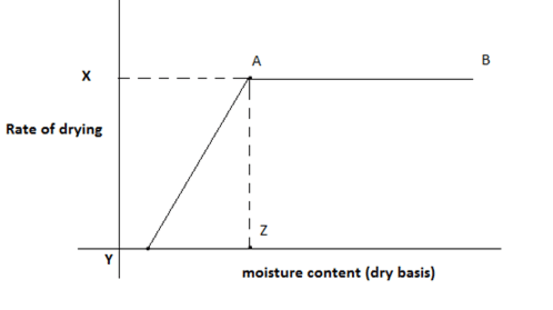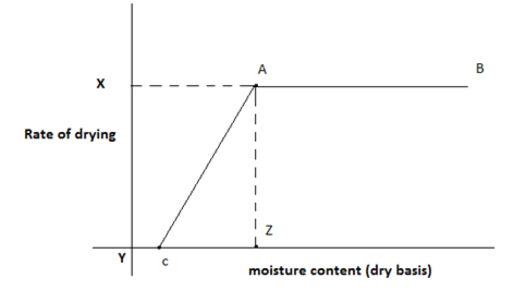This set of tricky Mass Transfer Questions & Answers focuses on “Time period Calculation in Drying”.
1. Find the time taken to dry 50% to 40% of moisture (dry basis) if critical moisture content is 30%. If the weight of the wet solid is 5 kg and the product of area and the constant rate is 0.5 kg/min.
a) 20 sec
b) 40 sec
c) 60 sec
d) 80 sec
View Answer
Explanation: Time for drying = ( wet solid weight * change in moisture )/ Area * constant rate
= (5 * 0.1/0.5) min = 1 min = 60 sec.
2. Find the period if the initial and the final moisture content are 60% and 40%. Also the critical moisture content is 30%.
a) Constant rate period
b) Falling rate period
c) Unsaturated period
d) None of the mentioned
View Answer
Explanation: Here the final moisture content is greater than critical moisture content so it must be a constant rate period.
3. Find the period if the initial and the final moisture content are 50% and 20%. Also the critical moisture content is 30%.
a) Constant rate period
b) Falling rate period
c) saturated period
d) None of the mentioned
View Answer
Explanation: Here the final moisture content is less than critical moisture content so it must be a falling rate period or unsaturated drying.
4. At the constant drying period of a batch process, the rate of drying varies accordingly.
a) True
b) False
View Answer
Explanation: For the constant drying period the rate of drying remains constant by analysing drying curve.
5. Find the change in moisture content from the given data
Given data:
Time for drying= 6 sec
Area * Constant rate = 8 kg per sec
Weight of wet solid = 100 kg
a) 0.21
b) 0.12
c) 0.48
d) 0.84
View Answer
Explanation: Difference in moisture = (time *area* rate )/Weight of the solid = 0.48.
6. Find the initial moisture content for the batch process if the final moisture content is 25% (dry basis) and the constant moisture content is 40%. (Includes constant and falling rate period)
a) 35
b) 30
c) 60
d) None of the mentioned
View Answer
Explanation: Here the initial moisture content must be greater than critical moisture content.
7. Find the final moisture content for the batch process if the initial moisture content is 75% (dry basis) and the constant moisture content is 40%. (Includes constant and falling rate period)
a) 45
b) 50
c) 60
d) None of the mentioned
View Answer
Explanation: Here the final moisture content must be less than critical moisture content.
8. Falling rate period of a batch process starts at
a) Saturated drying surface
b) Unsaturated drying surface
c) Both unsaturated and saturated region
d) None of the mentioned
View Answer
Explanation: The bound moistures gets evaporated only at unsaturated surface which is a falling rate period.
9. If the time taken for the moisture removal is obtained from the formula
Time = Ss(Xc – Xe)/ Nc * A ln ((X1-Xe)/(X2-Xe)) then the falling curve will be curves symmetrically
Where, Ss= Wet solid weight
Xc,Xe- constant & equilibrium moisture content
X1,X2 – initial and final moisture content
a) True
b) False
View Answer
Explanation: This relation gives the linear relation so the falling rate curve will be linear.
10. There will be a change in the rate of drying of a batch process after the constant drying process.
a) True
b) False
View Answer
Explanation: After the constant drying curve, the unsaturated drying starts then the rate of drying decreases due to moisture removal.
11. Find the Constant rate representation

a) X
b) Y
c) Z
d) A
View Answer
Explanation: Constant drying period has constant rate.
12. Find the representation of critical moisture content value

a) A
b) B
c) Z
d) Y
View Answer
Explanation: At the end of constant rate period we get critical moisture content value.
13. Find the equilibrium content value

a) A
b) B
c) C
d) Y
View Answer
Explanation: After the rate has stopped, the remaining moisture is known as equilibrium moisture content.
14. Falling rate period of the batch drying curve = _______ + ___________
a) Internal movement, unsaturated surface drying
b) Internal movement, saturated surface drying
c) External movement, unsaturated surface drying
d) External movement, saturated surface drying
View Answer
Explanation: From the drying curve we know the falling rate period represents the bound moisture removal so it includes internal movement and unsaturated surface drying.
15. Find the region if the final and the initial moisture content are 40% and 30% (Dry basis) and the critical moisture content is 45%.
a) Constant rate
b) Falling rate
c) Internal movement
d) None of the mentioned
View Answer
Explanation: Here both initial and final moisture content are less than critical moisture content so the rate is falling rate period.
Sanfoundry Global Education & Learning Series – Mass Transfer.
To practice tricky questions on all areas of Mass Transfer, here is complete set of 1000+ Multiple Choice Questions and Answers
If you find a mistake in question / option / answer, kindly take a screenshot and email to [email protected]
- Check Chemical Engineering Books
- Apply for Mechanical Engineering Internship
- Practice Mechanical Engineering MCQs
- Practice Chemical Engineering MCQs
- Check Mechanical Engineering Books
